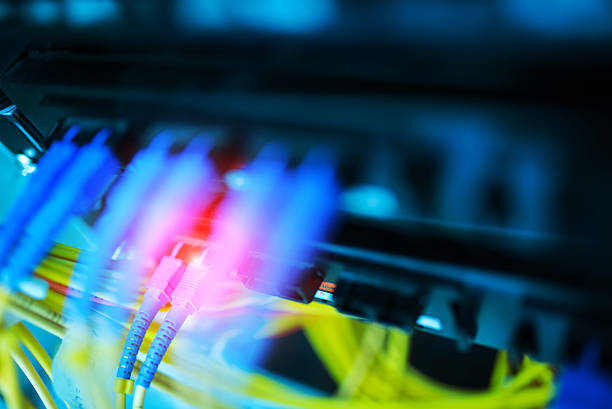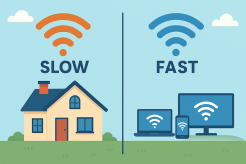Exploring Fiber Optic Internet Service Providers

With today's digital age, the demand for high-speed internet is higher than ever. From streaming high-definition videos to telecommuting and online gaming, robust internet connectivity is essential. Traditional broadband services often fall short in meeting these demands, leading to a growing interest in fiber optic internet. This article delves into the future of internet connectivity, focusing on the role and impact of fiber optic internet service providers.
What is Fiber Optic Internet?
Fiber optic internet is a type of broadband connection that uses fiber optic cables to transmit data. Unlike traditional copper wires, which use electrical signals, fiber optics use light signals to carry information. This method allows for significantly faster data transfer rates and greater bandwidth capabilities. Compared to DSL or cable internet, fiber optic internet offers a superior online experience, particularly in terms of speed and reliability.
How Fiber Optic Technology Works
Fiber optic technology is based on the transmission of data as pulses of light through thin strands of glass or plastic, known as optical fibers. Each fiber is capable of transmitting a vast amount of data over long distances without losing signal quality. The key components of a fiber optic network include the core, which carries the light signals, and the cladding, which reflects the light back into the core to prevent signal loss. This technology not only enables high-speed internet but also supports a range of other applications, from medical imaging to military communications.
Advantages of Fiber Optic Internet
Speed and Bandwidth
One of the most significant advantages of fiber optic internet is its incredible speed. Fiber optic connections can reach speeds up to 1 Gbps (gigabit per second) or higher, which is substantially faster than what most traditional broadband services offer. This speed is crucial for activities that require large amounts of data transfer, such as streaming 4K videos, online gaming, and downloading large files.
Reliability and Stability
Fiber optic internet is known for its reliability. Unlike copper cables, fiber optics are less susceptible to interference from electromagnetic signals, weather conditions, or physical damage. This stability ensures consistent internet speeds and reduces the likelihood of service interruptions, making it an ideal choice for both home and business use.
Future-Proof Technology
As technology advances, the demand for higher bandwidth and faster internet speeds will only increase. Fiber optic technology is inherently scalable, meaning it can accommodate future upgrades without the need for extensive infrastructure changes. This makes it a future-proof investment for both service providers and consumers.
Disadvantages and Challenges
Cost of Installation and Infrastructure
One of the primary challenges of fiber optic internet is the cost associated with its installation and infrastructure. Laying fiber optic cables requires significant investment, which can be a barrier for some service providers and municipalities. This cost is often passed on to consumers, making fiber optic internet more expensive than other options.
Availability in Rural Areas
While urban areas are rapidly adopting fiber optic technology, rural regions often lag behind. The high cost of deployment and lower population density make it less economically viable for providers to extend fiber networks to these areas. As a result, many rural residents still rely on slower, less reliable internet connections.
Maintenance and Repair Issues
Although fiber optic cables are generally durable, they can be difficult to repair if damaged. Specialized equipment and expertise are required to fix broken fibers, which can lead to longer repair times and higher costs compared to traditional copper cables.
Major Fiber Optic Internet Service Providers
Several major companies dominate the fiber optic internet market, each offering a range of services and packages to cater to different needs. Some of the leading providers include:
- Google Fiber: Known for its high-speed offerings and straightforward pricing.
- Verizon Fios: Offers a reliable and fast fiber optic service with extensive coverage.
- AT&T Fiber: Provides competitive speeds and bundled service options.
- Comcast Xfinity: While primarily a cable provider, Xfinity also offers fiber services in select areas.
Comparing these providers based on speed, pricing, and customer service can help consumers make an informed decision.
The Role of Fiber Optic Internet in Smart Homes
Smart homes rely heavily on stable and high-speed internet connections to function seamlessly. Fiber optic internet enhances the performance of smart devices by providing the necessary bandwidth for multiple devices to operate simultaneously. Whether it's smart thermostats, security cameras, or voice-activated assistants, fiber optic internet ensures that all devices remain connected and responsive.
Fiber Optic Internet and Business Connectivity
Benefits for Small Businesses
For small businesses, reliable internet connectivity is crucial for daily operations. Fiber optic internet supports faster upload and download speeds, which is essential for tasks such as video conferencing, cloud computing, and data transfer. This reliability can improve overall productivity and enable businesses to offer better customer service.
Impact on Large Enterprises
Large enterprises often require robust and scalable internet solutions to support their operations. Fiber optic internet provides the high bandwidth and low latency needed for complex applications, such as big data analytics, remote collaboration, and hosting multiple servers. This capability helps enterprises remain competitive in a digital-first world.
The Future of Fiber Optic Technology
Emerging Trends and Innovations
The future of fiber optic technology looks promising, with ongoing research and development aimed at enhancing its capabilities. Innovations such as quantum fiber optics and advancements in materials science could lead to even faster and more efficient data transmission. These developments have the potential to revolutionize internet connectivity, making it faster and more accessible than ever before.
Potential Advancements in Speed and Efficiency
Future advancements in fiber optic technology could result in speeds exceeding current capabilities by significant margins. Researchers are exploring ways to increase the data-carrying capacity of optical fibers, which could lead to multi-terabit per second speeds. Such improvements would cater to the ever-growing demand for bandwidth-intensive applications.
Government Initiatives and Support
Governments around the world are recognizing the importance of fiber optic internet and are implementing policies to promote its deployment. These initiatives include funding for infrastructure projects, tax incentives for service providers, and grants for rural broadband expansion. Such support is crucial for ensuring widespread access to high-speed internet.
Consumer Considerations When Choosing a Provider
When selecting a fiber optic internet service provider, consumers should consider several factors:
- Speed and Bandwidth: Ensure the provider offers speeds that meet your needs.
- Cost: Compare pricing and look for any hidden fees.
- Customer Service: Research the provider's reputation for customer support.
- Availability: Check if the service is available in your area.
- Contract Terms: Understand the terms and conditions before signing up.
By taking these factors into account, consumers can make an informed decision that best suits their internet usage requirements.
The Environmental Impact of Fiber Optics
Sustainability of Fiber Optic Technology
Fiber optic technology is generally more sustainable than traditional copper-based networks. It consumes less energy, reduces greenhouse gas emissions, and has a longer lifespan. Additionally, the materials used in fiber optics are more recyclable, contributing to a lower environmental footprint.
Comparisons with Other Technologies
Compared to wireless technologies, fiber optics offer a more environmentally friendly solution. Wireless networks require more energy and infrastructure to maintain, while fiber optics provide a more efficient and reliable connection with less environmental impact.
Fiber Optic Internet and Remote Work
Importance During the Pandemic
The COVID-19 pandemic highlighted the critical role of high-speed internet in enabling remote work. Fiber optic internet provided the necessary bandwidth and reliability for employees to work from home effectively, supporting video conferencing, file sharing, and other remote work applications.
Long-Term Benefits for Remote Workers
As remote work becomes a permanent fixture for many companies, fiber optic internet will continue to be essential. Its high speeds and stability ensure that remote workers can remain productive and connected, regardless of their location.
The Global Perspective
Adoption Rates Around the World
Fiber optic internet adoption varies widely across the globe. Countries like South Korea, Japan, and Sweden lead in fiber optic penetration, thanks to strong government support and investment. Meanwhile, other regions are gradually catching up as they recognize the benefits of high-speed internet.
Case Studies from Leading Countries
Examining case studies from countries with high fiber optic adoption can provide valuable insights. For example, South Korea's aggressive investment in fiber infrastructure has resulted in some of the fastest internet speeds in the world, driving economic growth and innovation.
Conclusion
In conclusion, fiber optic internet represents the future of connectivity, offering unparalleled speed, reliability, and scalability. While there are challenges to its widespread adoption, ongoing advancements and government support are paving the way for a more connected world. As consumers and businesses alike increasingly rely on high-speed internet, fiber optic technology will play a crucial role in meeting these demands and driving future innovations.
Related Posts

Fri, Dec 19, 2025 4:36 AM
SafetyEasy Ways to Keep Your Video Calls Secure
Learn practical ways to secure your video conferencing apps and protect your calls from unwanted access, cyberattacks, and privacy risks.

Fri, Dec 19, 2025 2:39 AM
Internet Bundles Broadband Deals TechnologyWhy Internet Bills Keep Going Up (And Why It Feels Constant)
Why do internet bills keep rising? Learn how ISP fees, limited competition, and pricing strategies quietly increase broadband costs.

Thu, Dec 18, 2025 3:59 AM
cheap internet dealsViasat (Exede) Satellite Internet Plans & Pricings
Explore Viasat (Exede) satellite internet plans, pricing, and speeds. Learn about availability, equipment, technology, and tips for rural and remote areas.

Thu, Dec 18, 2025 2:14 AM
SafetySimple Online Safety Tips Anyone Can Follow
Learn simple, practical ways to stay safe online—even if you’re not tech-savvy. Protect your data, avoid scams, and improve digital security with easy habits.

Wed, Dec 17, 2025 2:22 AM
WifiWhy’s My Internet Slower Than What I’m Paying For?
Paying for fast internet but getting slow speeds? Learn the real reasons your internet doesn’t match your plan and how to fix performance issues.